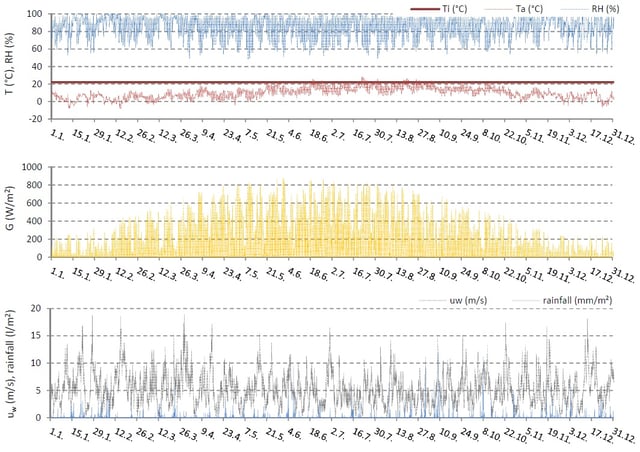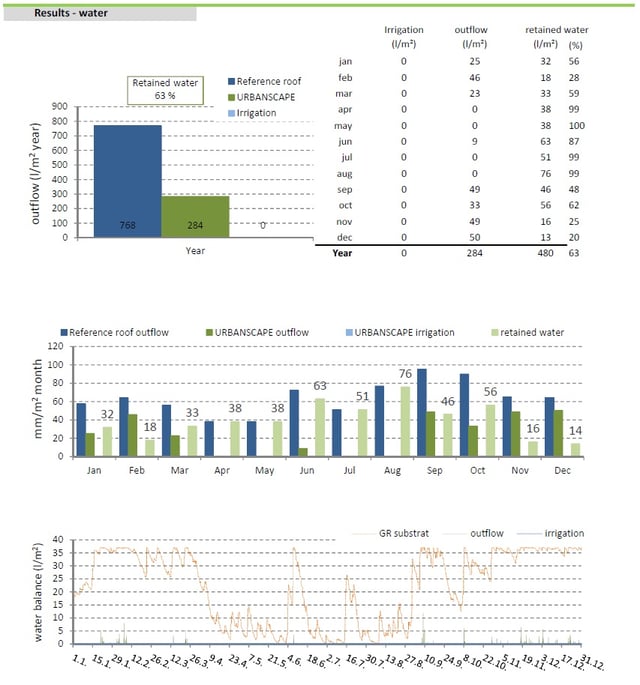Most urban conurbations contain large areas of paved or constructed surfaces which prevent stormwater from being absorbed into the ground. The resulting runoff can pollute and damage waterways and lead to flooding. One of the benefits of green roofs is their ability to help reduce stormwater pollution and flooding. Green roofs can reduce the flow of stormwater from a rooftop by up to 65% and slow the rate of runoff by up to three hours.
However, the efficiency of green roofs varies from one rainfall to another, and is dependent on climatic conditions and the specific design of the roof. This makes it difficult to provide broad statements on the stormwater performance of a green roof.
Green roofs are increasingly used as an official regulatory tool for stormwater management
Urban planners are beginning to specify green roofs within local and regional policies and are making them a mandatory element of many new builds. Therefore, understanding how a green roof should be designed to meet the required performance of is of paramount importance.
To do so, you first need to understand the five critical elements of the climate that affect stormwater performance.
Climatic Conditions that affect stormwater performance
-
Solar radiation – transforms water from liquid into gas – so it is triggering evaporation of water escaping from the green roof surface.
-
Temperature and solar radiation are connected. At the same time as the solar radiation is warming the surface of green roof it is also warming the air around it. In general, the higher the air temperature, the greater the evaporation as warmer air is able to hold more water vapour.
-
Relative Air Humidity – usually stated in %. So 50% means that air holds 50% humidity out of 100% capacity. When 100% is reached then air can no longer hold additional water vapour and so it condensates in the form of rain.
-
Wind – Wind speeds up evaporation. This is because it continually replaces the humid air above the evaporation area (the green roof surface) enabling additional evaporation to take place. This is why evaporation rates from green roofs are generally much higher than from regular gardens. The higher the speed of the wind, the greater will be evaporation as the humid air will move away faster.
-
Rain – If you have continuous or heavy rain, then the green roof will not be able to dry out and make space for new rainwater within the green roof substrate. When the green roof becomes fully saturated rainwater will simply run through the substrate and into the sewage.
The Urbanscape PET (Performance Evaluation Tool)
The Urbanscape PET (Performance Evaluation Tool) provides solid climatological data based on a multi-year study conducted in conjunction with the Faculty of Mechanical Engineering, University of Ljubljana, Slovenia. It involved studying hydrological responses of green roofs in different climatic conditions.
The Urbanscape PET makes it much easier to design and construct perfect green roof systems because it uses modelling to determine average rain water management performance, taking into consideration all key climate parameters and how they work together.
As a base for the key climate parameters for a green roof design, we use a reference year which is an average of more than 20 years’ historical climate data. Below is an example for Rotterdam:

Table 1: Reference year climate data for Rotterdam, NL
Using the same computer modelling we are able to design a roof according to the specifications and performance requirements specified by the customer or the regulations. We provide a clear stormwater performance sheet based on reference year climate data including:
- Yearly retained rainwater
- Monthly retained rainwater
- Daily water balance in the Green Roof System and real rainwater run-off
Below are examples of green roof designs for Rotterdam Municipality
Example – Results for Urbanscape Green Roof Premium (City of Rotterdam)

Green Roof Design
Based on the climatological data, several design elements can be adapted or included to improve water retention / holding capacity of the green roof system by:
- developing highly absorbent green roof growing media
- increasing the thickness of growing media (the main limitation is usually the weight of the growing media)
- selecting types of plants that are able to absorb more water during the rainy seasons and
- developing / constructing innovative types of drainage systems (although with this element we are entering into the “blue roof industry”)
The result of the change of parameters in the design can be checked again with the PET to ensure the desired performance will be reached. By helping to understand the effect of the climatic conditions and design elements of the green roof we can optimise and ensure the performance of green roofs, not only with regards to stormwater control, but also with regards to heat island effect mitigation and energy savings.
How the PET helps to ensure the performance of green roofs with regards to these two topics will be discussed in future blogs.
If you are interested in receiving a sample Performance evaluation report for a selected town / country, please click here:
To learn more, check our website or download our Green Roof System Brochure.



